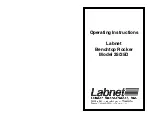
All PMI Life Safety Ropes are built to meet Cordage
Institute Standards for Life Safety Ropes and other
standards as noted.
PMI has earned ISO 9001 registration from SGS Yarsley.
Constant monitoring of materials and processes are an
essential part of our ISO Quality Management System.
THANK YOU FOR USING PMI ROPES
PMI LABELING
ROPE CLEANING
ROPE INSPECTION
PMI maintains a Quality Assurance Program, meeting all the
requirements of ISO 9001, NFPA 1983, and the PPE directive.
PMI’s CE accreditation for the listed products has been issued by
SGS Yarsley ICS Ltd., SGS House, 217221 London Road, Camberley,
Surrey GU15 3EY United Kingdom. Notifi ed Body 0120.
PMI’s NFPA marking has been issued by Underwriters Laboratories
(UL), USA.
External Markings (tapes) are placed on the ends of all PMI ropes to
indicate the PMI name/logo. At least one end will have an additional
label with the Lot Number, diameter, length, part number, bar code,
and all applicable certifi cation information.
Internal Markings (tapes) are placed inside the rope along with the
core yarns during manufacture. These printed tapes identify PMI,
made in USA, rope material(s), date of manufacture, rope type and
relevant standard(s).
Cut lengths of rope should be retrofi tted if necessary with the external
marking (as explained above) by the user.
Wash It
- You can wash dirty ropes by hand or in a front-loading
commercial washing machine using cold to warm water with a
mild soap. Non detergent soaps are best, but a mild detergent is
acceptable if used sparingly. Soap used should not contain any
bleaching agents. Avoid top loading washing machines with agitators
because they tangle the rope severely and might even cause damage
from friction produced by rubbing of the synthetic rope against
the synthetic agitator. Note: Ropes will shrink up to about 6% after
washing.
Disinfect It
- Disinfection needs only to be done in the event of
suspected blood borne pathogens. To disinfect a rope from suspected
blood-borne pathogens PMI recommends following the NFPA standard
for cleaning rescue gear of blood-borne pathogens. Prepare a
solution of 60 ml of household bleach for every 4 liters of tap water
or cup per gallon. Soak the rope for 10 minutes in this solution, then
thoroughly rinse or wash as noted above. The rinsing cycle is critical to
prevent any damage to the rope from the bleach. Allow the rope to
dry in a cool, dry, well ventilated area.
Lubricate It
- Ropes may dry out and lose some fl exibility as a result
of washing. You can prevent this by occasionally adding a little fabric
softener (about a cup of Fabric Softener) to the rinse cycle during
rope washing. Don’t use any more than this or it might damage the
rope.
Dry It
- Dry your rope in a clean, dry area out of direct sunlight. Avoid
1) commercial dryer, 2) placing wet ropes on a concrete surface,
and 3) exposure to exhaust fumes. For best results, the rope should
be laid in a loose coil or coiled around two objects in a low-humidity
environment.
Write It Down
- Remember to record the cleaning on the Rope Log.
Keep It Clean
- After repacking, store your rope in a clean, dark, dry
environment, away from exposure to acids, other harmful chemicals,
noxious fumes or other abuse.
BEFORE YOU START
All ropes should be inspected for wear and damage before each use.
If it hasn’t been inspected, DON’T USE IT! Always inspect the entire
length of the rope, even when you don’t use all of it. Keep in mind
that it is diffi cult to inspect wet rope. It is best to dry it fi rst before
inspecting it. Let one person complete the entire inspection of one
rope. If you start splitting this job between different persons, they
might miss something important.
HOW TO INSPECT YOUR ROPE
1) Look at it.... All of it! - Start at one end and look at every inch of
the rope. Watch for signs that might indicate possible damage such
as discoloration, chemical odors, abrasion, cuts or nicks in the outer
sheath and visible differences in the diameter of the rope in one area
in relation to the rest of the rope.
2) Wrap it in Small Loops and Look! - Wrap the rope around your
hand to form small loops at different random points along the ropes
length. Look at these small loops as you make them, the consistency
of the loop should be uniform throughout. If it’s not, you might have a
problem with the ropes core.
3) Feel the rope! - While you are looking at every inch of the rope,
run it through your bare hands and feel it for changes that might mean
damage to the core. Changes may include any inconsistencies in rope
diameter, soft or “mushy” spots, or extraordinarily stiff areas.
4) Write it all down! - Write the results of your inspection on the Rope
Log included with your rope. Be sure to include anything you found
in your inspection that might be or become a problem and document
other important information about the rope such as an occurrence of
uncontrolled or excessive loading, rope older than 10 years, contact
with harmful chemicals, history of use.
5) If in doubt, THROW IT OUT! If you are not sure about the integrity
of a rope........DON’T USE IT!
Consult the manufacturer if you need help.
Make a note on the Rope Log every time something happens to the
rope including usage, inspection, cleaning, drying, or problems.
For additional information about this or other PMI products, contact us.
Pigeon Mountain Industries, Inc.
Toll Free: 888.764.1437
PO Box 803
Phone: 706.764.1437
LaFayette, GA 30728
Fax:
800.952.3747
Email:
Web:
www.pmirope.com
ADDITIONAL INFORMATION



























